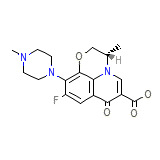Leroxacin




Categoria
Leroxacin Marchi, Leroxacin Analoghi
Leroxacin Marchi miscela
Leroxacin Formula chimica
C36H42F2N6O9
Leroxacin RX link
http://www.rxlist.com/cgi/generic2/quixin.htm
Leroxacin FDA foglio
Leroxacin DMS (foglio di materiale di sicurezza)
Leroxacin Sintesi di riferimento
Mitscher, Lester A. et al,. J.Med.Chem;. 30, 12, 2283-2286 (1987)
Leroxacin Peso molecolare
740.751 g/mol
Leroxacin Temperatura di fusione
No information avaliable
Leroxacin H2O Solubilita
Insolubile
Leroxacin Stato
Solid
Leroxacin LogP
1.268
Leroxacin Forme di dosaggio
Compressa, liquidi; Soluzione
Leroxacin Indicazione
Per il trattamento della congiuntivite batterica causata da ceppi sensibili dei seguenti organismi: specie Corynebacterium, Staphylococus aureus, Staphylococcus epidermidis, Streptococcus pneumoniae, , Streptococcus (Gruppi C / F / G), gli streptococchi del gruppo viridans, Acinetobacter lwoffii, Haemophilus influenzae, Serratia marcescens.
Leroxacin Farmacologia
Levofloxacina, un fluorochinolone antinfettivo, è otticamente attivo L-isomero di ofloxacina. Levofloxacina è usato per trattare la congiuntivite batterica, sinusite, bronchite cronica, polmonite acquisita in comunità e polmonite causata da ceppi resistenti alla penicillina di Streptococcus pneumoniae, infezioni della struttura della pelle e della pelle, infezioni complicate delle vie urinarie e pielonefrite acuta.
Leroxacin Assorbimento
L'assorbimento di ofloxacina dopo dosi singole o multiple da 200 a 400 mg è prevedibile, e la quantità di farmaco assorbita aumenta proporzionalmente con la dose.
Leroxacin Tossicita
Gli effetti collaterali includono disorientamento, vertigini, sonnolenza, vampate di calore e di freddo, nausea, impastando di parola, gonfiore e intorpidimento del viso
Leroxacin Informazioni paziente
PATIENT INFORMATION
While taking ofloxacin patient should be advised to:
� to drink fluids liberally;
� that mineral supplements, vitamins with iron or minerals, calcium- , aluminum-, or magnesium-based antacids, sucralfate or Videx�, (Didanosine), chewable/buffered tablets or the pediatric powder for oral solution should not be taken within the two-hour period before or within the two-hour period after taking ofloxacin;
� that ofloxacin can be taken without regard to meals;
� that ofloxacin may cause neurologic adverse effects (e. g. , dizziness, lightheadedness) and that patients should know how they react to ofloxacin before they operate an automobile or machinery or engage in activities requiring mental alertness and coordination;
� to discontinue treatment and inform their physician if they experience pain, inflammation, or rupture of a tendon, and to rest and refrain from exercise until the diagnosis of tendinitis or tendon rupture has been confidently excluded;
� that ofloxacin may be associated with hypersensitivity reactions, even following the first dose, to discontinue the drug at the first sign of a skin rash, hives or other skin reactions, a rapid heartbeat, difficulty in swallowing or breathing, any swelling suggesting angioedema (e. g. , swelling of the lips, tongue, face; tightness of the throat, hoarseness), or any other symptom of an allergic reaction
� to avoid excessive sunlight or artificial ultraviolet light while receiving ofloxacin and to discontinue therapy if phototoxicity (e. g. , skin eruption) occurs;
� that if they are diabetic and are being treated with insulin or an oral hypoglycemic drug, to discontinue ofloxacin immediately if a hypoglycemic reaction occurs and consult a physician;
� that convulsions have been reported in patients taking quinolones, including ofloxacin, and to notify their physician before taking this drug if there is a history of this condition.
While taking ofloxacin patient should be advised to:
� to drink fluids liberally;
� that mineral supplements, vitamins with iron or minerals, calcium- , aluminum-, or magnesium-based antacids, sucralfate or Videx�, (Didanosine), chewable/buffered tablets or the pediatric powder for oral solution should not be taken within the two-hour period before or within the two-hour period after taking ofloxacin;
� that ofloxacin can be taken without regard to meals;
� that ofloxacin may cause neurologic adverse effects (e. g. , dizziness, lightheadedness) and that patients should know how they react to ofloxacin before they operate an automobile or machinery or engage in activities requiring mental alertness and coordination;
� to discontinue treatment and inform their physician if they experience pain, inflammation, or rupture of a tendon, and to rest and refrain from exercise until the diagnosis of tendinitis or tendon rupture has been confidently excluded;
� that ofloxacin may be associated with hypersensitivity reactions, even following the first dose, to discontinue the drug at the first sign of a skin rash, hives or other skin reactions, a rapid heartbeat, difficulty in swallowing or breathing, any swelling suggesting angioedema (e. g. , swelling of the lips, tongue, face; tightness of the throat, hoarseness), or any other symptom of an allergic reaction
� to avoid excessive sunlight or artificial ultraviolet light while receiving ofloxacin and to discontinue therapy if phototoxicity (e. g. , skin eruption) occurs;
� that if they are diabetic and are being treated with insulin or an oral hypoglycemic drug, to discontinue ofloxacin immediately if a hypoglycemic reaction occurs and consult a physician;
� that convulsions have been reported in patients taking quinolones, including ofloxacin, and to notify their physician before taking this drug if there is a history of this condition.
Leroxacin Atto interessato organismi
Batteri enterici e altri eubatteri














